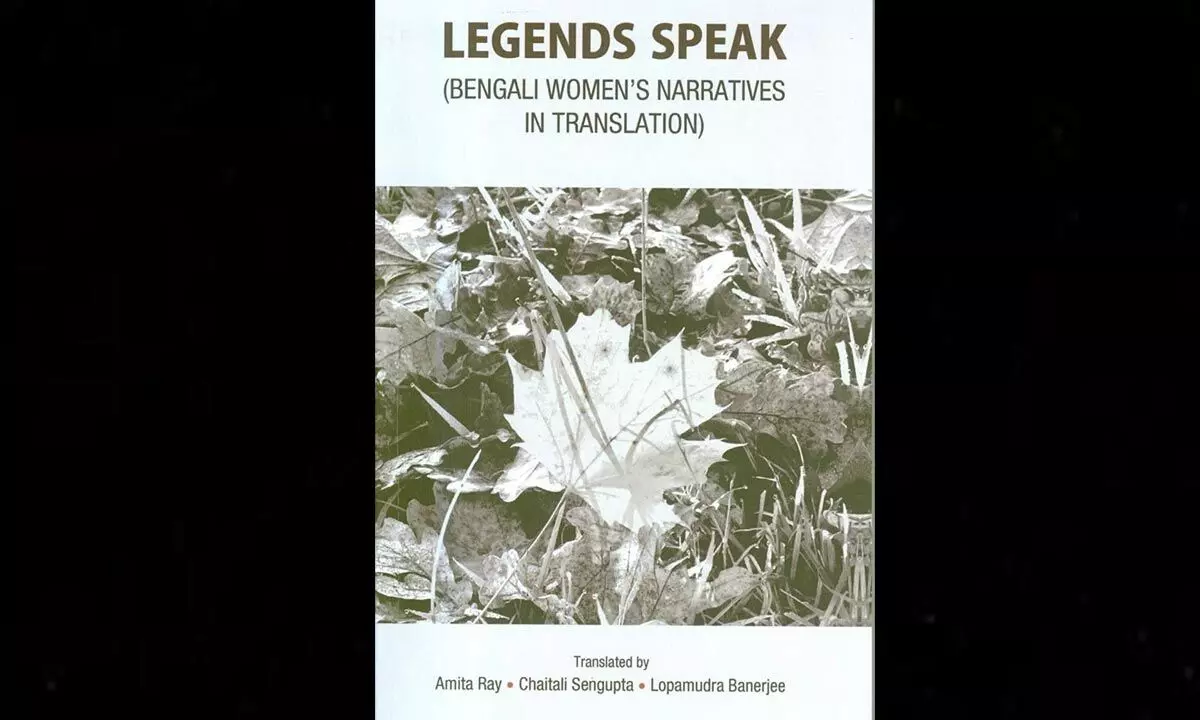Live
- Now, tackle pest menace in hostels with LED lights
- Hyderabad: Students protest over appointing Physics prof as EdCET convener
- Young doctors urged to work for healthy community
- Bhavani Deeksha Viramana continues
- Sridhar Babu hardsells key sectors to Malayasia
- Health Min Damodar Raja Narsimha holds meet to improve infra in govt hosps
- Inter exam fee last date extended
- Outrage as stray dogs poisoned in Sullurpeta
- Hyderabad soaks in vibrant Yuletide spirit
- Heavy rains forecast at isolated places in AP
Just In

A masterpiece of translation
In the complex translation work ‘Legends Speak: Bengali Women’s Narratives in Translation, the three women translators, Amita Ray, Chaitali Sengupta, and Lopamudra Banerjee, have successfully recreated three gems for the readers of world literature.
In the complex translation work 'Legends Speak: Bengali Women's Narratives in Translation, the three women translators, Amita Ray, Chaitali Sengupta, and Lopamudra Banerjee, have successfully recreated three gems for the readers of world literature.
The book is remarkable for it explores feminism through the eyes of Bengali women authors spanning a remarkably significant period of over a hundred years. While in Swarnakumari's novel, the picture which emerges is of women as passive recipients, oppressed entities, and subjected to constraints, and limitations, in both Ashapurna's and Suchitra Bhattacharya's stories, we see women questioning and attempting to resist the patriarchal norms.
The book opens with the translation of a story by Swarnakumari Debi called Chinna Mukul (The uprooted blossom). Swarnakumari's contribution to Bengali literature and culture, as a bright member of the reputed Tagore family, is not forgotten by the lovers of literature. Her beautiful narrative outpouring is translated deftly by Chaitali Sengupta, who reveals her finesse and dexterity as a translator as she turns Swarnakumari's spellbinding novella into accomplished translation work.
In her authentic, freely flowing style, she carves out the heart-breaking tribulation of the main protagonist Kanaklata. She engages in the modern-day, crisp language, dissolving the margin between the past and the present, and vividly portrays Swarnakumari's brilliant novella. By translating the legendary Swarnakumari's classic work into English, Sengupta has revived Swarnakumari's work and proved her excellence in recreating and capturing the original work with great narrative flexibility. I'm sure the readers will find it immersive, timely, and original.
The book is enriched for featuring the brilliant work of the prominent Bengali novelist and poet Ashapurna Debi. Her world is a world of Bengali middle-class, domestic women situated within a rigid patriarchal social construct. Still, within that construct, the strong feminine presence of her protagonists is felt as they challenge stereotypical social norms and break the status quo in their unique ways.
For this volume of translation, experienced translator Lopamudra Banerjee has selected Debi's novella 'Nacchor' (The incorrigible), which is a woman's journey of self-exploration, nostalgia, and love. Banerjee's sober, masterly translation gives a fresh nuance to one of Ashapurna's masterpieces. Moreover, she handles Ashapurna's novella with complete assurance.
The most recent author who speaks in Legends Speak is Suchitra Bhattacharya, a powerful and famous novelist of contemporary Bengali literature. Her novella Shunyo theke shunyo (The Void) is, in the words of Dr. Sanjukta Dasgupta, who has written a beautiful foreword in this book, "a tri-generational narrative that once again represents continuity and change as an internalized factor in Bengali society." Although not very well-known outside Bengal, Bhattacharya wrote extensively about the state of urban middle-class women in the society. Her understanding of human nature and its varied manifestations is also evident in her novel The Void. Amita Ray, who has shown her ability and caliber in her other translated works, also holds her forte exceptionally well this time. She has recreated the lucid style of Bhattacharya in English and the result is an engaging, easy-flowing translation!
The interest of the three translators of this book is to promote and support the development of Bengali literature by translating those into English has undoubtedly added to the prosperous literary tradition. They have managed to deliver successful translation work. In this regard, Chaitali Sengupta, Lopamudra Banerjee, and Amita Ray have acted as 'creative mediators' and brought out a fluent, agile, readable, and creative literary work in English. With all due regard and respect to the original masterpieces, this work will live on its own.

© 2024 Hyderabad Media House Limited/The Hans India. All rights reserved. Powered by hocalwire.com







